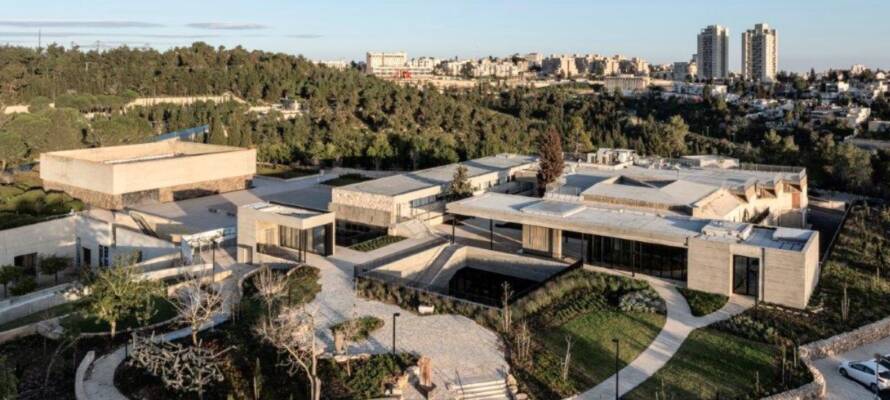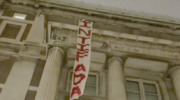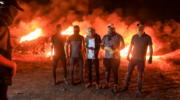‘These are our crown jewels,’ Yad Vashem chairman Dani Dayan told the audience at a concert commemorating the opening.
By Judy Lash Balint, JNS
Yad Vashem, the World Holocaust Remembrance Center in Jerusalem, earlier this week inaugurated a new home for the world’s largest collection of Shoah-related materials.
Donors, dignitaries, Yad Vashem staff and survivors gathered to mark the opening of the Moshal Shoah Legacy Campus, which includes the David and Fela Shapell Family Collections Center.
The Legacy Campus brings together under one roof a state-of-the-art facility for the collection, conservation, and preservation of tens of thousands of Holocaust-related items gathered over decades from survivors and their families.
Along with the artifacts, more than 230 million pages of testimony and documents, and half a million photographs, will now be stored and preserved in optimal conditions in the new six-story building at the center of the Mount of Remembrance where Yad Vashem is located.
“These are our crown jewels,” Yad Vashem chairman Dani Dayan told the audience at a concert commemorating the opening. “They are a living testament to Jewish history. We have a moral imperative to safeguard our heritage.”
By the end of the 1960s, around half a million survivors of the Holocaust had immigrated to Israel. In the 1990s, they were joined by tens of thousands of Jews from the Former Soviet Union who survived the Shoah.
Among the treasured possessions many of these people managed to bring to Israel were diaries, photos, art depicting their experiences, documents illustrating Jewish life before and during the Holocaust, items of Judaica, prayer books, musical instruments, and toys that had provided comfort during their ordeal.
Over the years, particularly after the opening of Eastern Europe in the late 1980s, Artifacts Collection staff from Yad Vashem traveled all over the world to gather items.
With the opening of the Holocaust History Museum at Yad Vashem in 2005, more than 1,000 items were put on public display for the first time.
In 2011, a formal program called Gathering of the Fragments was launched in Israel urging anyone with Holocaust-related items at home to bring them to Yad Vashem to be preserved, cataloged, and digitized before they decayed.
Tens of thousands of artifacts have been collected and exhibited over the past 13 years.
Several precious musical artifacts were used at the commemorative concert to mark the opening held at the Jerusalem Theater.
Jerusalem Symphony’s first violinist Janna Gandelman played a violin with its Yad Vashem preservation tag hanging from its neck, and four of the orchestra’s violinists used instruments that had belonged to Jews before and during the Shoah that were rescued by Violins of Hope.
One violin that was owned by Motale Shlain, a Jewish partisan killed by Nazis, made its way to Yad Vashem via a fellow partisan who survived.
The instrument is part of the Artifacts Collection and was used at the Jerusalem concert by violinist Mordechay Shenvald to play the theme from Steven Spielberg’s 1993 film, “Schindler’s List.”
Shenvald, an IDF reservist and grandson of an Auschwitz survivor, was severely wounded in battle in Gaza in late October 2023 and attributes his recovery to the use of music during his complex rehabilitation.
On a recent visit to the textile conservation lab at the new Moshal Shoah Legacy Campus, a battered teddy bear donated by Stella Knobel lay in a box waiting to be reshelved.
Knobel, born in 1931, received it as a gift for her seventh birthday in Krakow, Poland. She was one of the “Tehran Children” who arrived in Palestine in 1943, clutching her teddy bear.
When she gave the bear to Yad Vashem, she said, “He’s part of my family, the last remnant of my home in Poland. I know that in Yad Vashem he’ll be taken care of. The thought that he could be thrown in the garbage is terrible to me. It (the teddy) is symbolic of my life.”
The Moshal Shoah Legacy Campus with The David & Fela Shapell Family Collections Center at its heart, was built to house the world's largest repository of Shoah-related art, artifacts & archival materials, preserving the voices & stories of Shoah victims & survivors for posterity pic.twitter.com/i47tk7fRIJ
— Yad Vashem (@yadvashem) July 8, 2024
‘A balance between past and future’
Simmy Allen, head of Yad Vashem’s International Media Section, tells visiting journalists that it was a very difficult process for Knobel to part with the childhood treasure, but “we worked together with her family to acquire it, because it’s important to showcase what life was like for children during the Holocaust.”
Allen points out that it took a worldwide search to find qualified professionals in the conservation and restoration field to staff the Center.
Sarah Reichert, an art conservator, made aliyah from Paris; photo conservator Reut Ilan-Shafik was trained in Berlin, and textile conservator Nada Reizman hails from St. Petersburg.
One exception is document conservation expert Yuval Siton, who was trained in Israel and has worked at Yad Vashem for 22 years.
Items that have passed through his hands over those years include postcards sent by Anne Frank; poems of paratrooper and Holocaust rescuer Hannah Senesh; and the blueprints of the Auschwitz death camp.
Because of the fragile nature of the artifacts, the conservation and preservation labs are not open to the public, but the building is designed around a sunken courtyard with windows that look into the labs.
“The facility was designed to strike a delicate balance between conservation and accessibility, between past and future,” says Dayan.
In the art lab, Sarah Reichert is working on several large canvases.
She notes that there are some 1,000 oil paintings at Yad Vashem, “and they are not Rembrandts. A minor amount of the artwork that we have here is actual oil paint; the majority is drawings on scraps of paper and the rest are more items that were drawn on anything and everything that you can imagine, from eggshells to sacks of potatoes.”
She says that “every painting has multiple stories of what it depicts, who created it, how it survived and how it arrived. If we bring back a painting and realize that it was created under the most horrific conditions that could possibly be thought or even imagined, the fact of the matter is that our job is to document, to keep the memory of the Holocaust for generations to come.”
Reichert explains that her efforts are not to restore the artwork, but rather to maintain it and preserve it in the condition in which it arrived at Yad Vashem, or at least in the condition in which it was found after the Holocaust, “because every burn mark, every stain, every hole, every pattern on a piece of paper has a story of its own.”
Many of the artworks and artifacts are viewable on the Yad Vashem Online Exhibition section in eight languages.
Objects can tell the story of the #Shoah and the murdered men, women and children in a touching way. @yadvashem has opened its new Moshal Shoah Legacy Campus with millions of documents and artefacts. The German Government and several German companies contributed to the effort. pic.twitter.com/iYL78usZnd
— Steffen Seibert (@GerAmbTLV) July 8, 2024
ANTISEMITISM IS SURGING, THREATENING JEWISH LIVES!
Join Six Million United Against Antisemitism!
We stand united against antisemitism and pledge to fight hatred and violence against the Jewish people and its institutions around the world.
Sign the petition - Declare 'Never Again is Now'!























